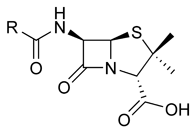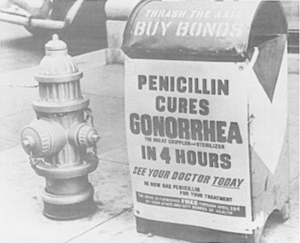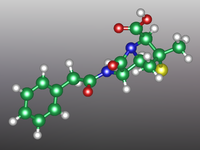In October 1998, the Maryland Department of Health and Mental Hygiene (MDH) was notified that a public sexually transmitted disease (STD) clinic in a county (county A) had used a nonrecommended preparation to treat syphilis patients during January-October 1998. The clinic had been inadequately treating syphilis patients or syphilis contacts with Bicillin(r)[*] C-R (a mixture of 1.2 million units [MU] benzathine penicillin G [BPG] and 1.2 MU procaine penicillin G), rather than with Bicillin(r) L-A (2.4 MU BPG). Compared with short-acting procaine penicillin G, BPG has a longer half-life considered essential for effective syphilis treatment because it yields sustained spirochetecidal levels needed to treat the slowly reproducing agent of syphilis, Treponema pallidum. The inadvertent use of Bicillin C-R, which contains only half the recommended dose of BPG for syphilis, was recognized by a health-care provider at the STD clinic in a neighboring county (county B) approximately 1 month after county B had borrowed BPG from county A. This report summarizes the investigation of the use of Bicillin C-R to treat STD patients in county A and discusses the frequency of Bicillin C-R use in STD clinics nationwide. Findings of this investigation indicate that inadvertent Bicillin C-R use is more frequent than previously known and that preventive measures should be taken to minimize such use.
Three BPG-containing products are marketed by Wyeth-Ayerst Laboratories (Philadelphia, Pennsylvania): Bicillin L-A, Bicillin C-R, and Bicillin(r) C-R 900/300 (a mixture of 0.9 MU BPG and 0.3 MU procaine penicillin G). Besides having similar proprietary names, the package and label for Bicillin C-R and Bicillin L-A have similar lettering and colors. Bicillin L-Ais recommended fortreating syphilis patients and upper respiratory tract infections caused by susceptible streptococci [1]. The efficacy of Bicillin C-R to treat syphilis is unknown. The package insert for Bicillin C-R states that this product should not be used to treat syphilis, gonorrhea, yaws, bejel, or pinta.
To identify patients who might have been treated with Bicillin C-R at county A's STD clinic, investigators reviewed the clinic's invoice records and the penicillin injection log. MDH searched its STD surveillance database for residents from county A who were treated for syphilis or had a positive syphilis serology during January- October 1998.
During December 1997-May 1998, 150 doses of Bicillin C-R were shipped to county A's STD clinic after orders for Bicillin L-A were placed by telephone. During January- October 1998, 123 of 160 doses of penicillin administered for syphilis were Bicillin C-R. Sixty-three patients, including five pregnant women, might have received Bicillin C-R. Because the efficacy of Bicillin C-R for treatment of patients with syphilis is unknown, the clinic attempted to contact and treat all patients with Bicillin L-A. During this period, routine outreach activities were suspended, clinic hours were extended, and personnel were asked to work overtime.
Clinic workers contacted patients by telephone, and subsequent clinical evaluations were made by two nurses. STD field staff visited patients in their homes; multiple attempts were often needed to locate and counsel patients. Although the five pregnant women were located and treated with Bicillin L-A, four infants were treated for congenital syphilis because their mothers had not been treated adequately at least 30 days before delivery. None of the infants had congenital syphilis.
After 8 weeks of follow-up efforts, 52 (82%) of the 63 patients had been restreated and retreated; the remaining 11 patients either could not be located (one) or refused retreatment (10). The total estimated direct costs of follow-up efforts conducted by county A's clinic was approximately $24,000.
In county B, 10 syphilis patients received Bicillin C-R during an 11-day period according to the clinic's syphilis treatment records. Of these, eight were treated with Bicillin L-A, one was not located, and the other refused further treatment.
To determine the frequency of Bicillin C-R use in STD clinics nationwide and to educate STD program managers about the possible confusion between Bicillin C-R and Bicillin L-A, CDC surveyed 65 STD program areas during January-February 1999 about unintentional Bicillin C-R use from 1993 through 1998. Fifty-seven of the 65 program areas were state/city program areas, and the remainder were islands and territories; 55 (96%) of the state/city program areas responded to the survey. Of these, 45 (82%) used only Bicillin L-A to treat syphilis patients, three used Permapen(R) exclusively (a BPG product from Pfizer, Inc. [New York, New York]), and seven used both Permapen and Bicillin L-A. Besides the Maryland clinics, four program areas reported unintentional Bicillin C-R use at least once from 1993 through 1998. In two areas, Bicillin C-R was received at the state health department and was distributed to STD clinics statewide; the administration of a nonrecommended regimen subsequently occurred at many local STD cl inics. Two other areas reported unintentional use of Bicillin C-R at individual clinics (one area reported multiple occurrences). In March 1999, unintentional use of Bicillin C-R was reported from a program area that had responded negatively to the earlier survey. The number of persons who received a nonrecommended regimen in this incident could not be determined.
Among the 55 state/city program areas that responded to the survey, 31(56%) were unaware of the possible confusion between Bicillin C-R and Bicillin L-A; 24 (46%) program areas routinely ordered Bicillin L-A by telephone.
Reported by: D Dwyer, MD, State Epidemiologist, Maryland Dept of Health and Mental Hygiene. Div of STD Prevention, National Center for HIV, STD, and TB Prevention; and an EIS Officer, CDC.
Editorial Note: The inadvertent use of Bicillin C-R in county A's STD clinic disrupted routine public health functions and incurred substantial monetary costs to the clinic and unnecessary discomfort to patients. Such incidents may undermine the credibility of and trust in health departments on the part of affected patients and the broader community. Although no treatment failures or congenital syphilis cases were associated with this incident, treatment according to standard guidelines was missed for patients who either could not be relocated or refused retreatment.
In addition to Maryland, five program areas reported unintentional use of Bicillin C-R from 1993 through 1998. This number should be viewed as a conservative estimate because some program areas might have failed to report such use because of concerns over liability or performance evaluation. Because most program areas surveyed were unaware of the possible confusion between Bicillin C-R and Bicillin L-A, some unintentional Bicillin C-R use could have occurred that remained unknown.
Penicillin therapy is the mainstay of treatment and a core element of syphilis prevention in the United States [2,3]. However, declining syphilis rates may have caused providers to become less familiar with the penicillin regimens appropriate for syphilis. Less attention may have been paid to clinician outreach and training for medications used to treat a disease that has declined as sharply as syphilis (83% decline in primary and secondary syphilis from 1990 to 1997 in the United States) [4].
Sustained participation by manufacturers in providing diagnostic and therapeutic products is an essential element of emerging initiatives to eliminate syphilis transmission in the United States [5]. Increased efforts are needed to re-educate clinic managers and providers about the existence of different penicillin preparations and their appropriate usage. Written rather than telephone orders may help to minimize ordering or shipment errors. Although the most important safeguard against medication errors is that providers carefully read package labels, some label and package modifications may help decrease confusion about Bicillin products and other pharmaceuticals with similar names and labels.
References
(1.) Bisno AL, Gerber MA, Gwaltney JM, et al. Diagnosis and management of group A streptococcal pharyngitis: a practice guideline. Clin Infect Dis 1997;25:574-83.
(2.) CDC. Recommendations for treatment of sexually transmitted diseases. MMWR;47(no. RR-1): 28-40.
(3.) Augenbraun MH, Rolfs R. Treatment of syphilis, 1998: nonpregnant adults. Clin Infect Dis 1999; 28(suppl 1):S21-S28.
(4.) CDC. Primary and secondary syphilis--United States, 1997. MMWR 1998;47:493-7.
(5.) St. Louis ME, Wasserheit JN. Elimination of syphilis in the United States. Science 1998;281:353-4.
(*.) Use of trade names and commercial sources is for identification only and does not imply endorsement by CDC or the U.S. Department of Health and Human Services.
COPYRIGHT 1999 U.S. Government Printing Office
COPYRIGHT 2004 Gale Group




